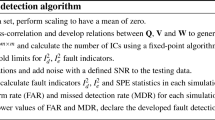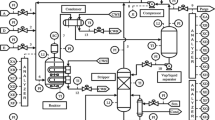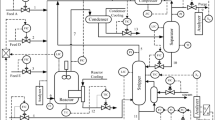Abstract
Data-driven is the use of data to drive knowledge and decisions. This has the potential to produce better results but can also suboptimal based on a misinterpretation of data, faulty data, and/or missing data. It is therefore interesting to study the problem of uncertainties in the data and how to integrate them into the models in order to improve performances. Principal component analysis (PCA) is one of the most popular data-driven approaches that is not designed to handle the uncertainty of the sensor measurements represented by interval type data. The complete information PCA (CIPCA) is one of the pioneering static approaches in the processing of interval data. Because the process operating conditions and their parameters may vary over time, as well as the oldest data that are not representative of the current process operation, a continuous update of the CIPCA model is necessary. The objective of this paper is to design an adaptive version of the CIPCA methodology for handling complex data, i.e., time-varying and interval data. At each time instant, when a new uncertain measurement of interval type is available, the CIPCA model is recursively updated, where recursive formulas for updating weighted mean and covariance matrix of interval-valued data are proposed. Indeed, the proposed CIPCA approach allows a robust and recursive representation, which improves fault detection and isolation decisions. Based on the updated CIPCA model, the interval \(T^2\) and SPE statistics are calculated and used to monitor the operating conditions of a process. A wind turbine benchmark is adopted to confirm the effectiveness of the proposed method. The results show that the proposed adaptive CIPCA method for fault detection and isolation in wind turbines is quite promising.
















Similar content being viewed by others
References
Patton Ron J, Frank Paul M, Clark Robert N (2013) lssues of fault diagnosis for dynamic systems. Springer, Berlin
Tkachenko R, Izonin I (2018) Model and principles for the implementation of neural-like structures based on geometric data transformations. In: Hu Z, Petoukhov S, Dychka I, He M (eds) Advances in computer science for engineering and education. ICCSEEA advances in intelligent systems and computing. Springer, Cham
Izonin I, Tkachenko R, Kryvinska N, Tkachenko P, Gregušml M (2019) Based Multiple Linear Regression on Coefficients Identification Using Non-iterative SGTM Neural-like Structure. In: Rojas I, Joya G, Catala A (eds) Advances in Computational Intelligence IWANN. Lecture notes in computer science. Springer, Cham
Chakour C, Harkat M-F, Djeghaba M (2015) Neuronal principal component analysis for nonlinear time-varying processes monitoring, IFAC-PapersOnLine, 48(21). ISSN 1408–1413:2405–8963
Hastie T, Stuetzle W (1989) Principal curves. J Am Stat Assoc 84(406):502–516
Kramer MA (1991) Nonlinear principal component analysis using autoassociative neural networks. AIChE J 37(2):233–243
Dunia R, Qin SJ, Edgar TF, McAvoy TJ (1996) Identification of faulty sensors using principal component analysis. AIChE J 42(10):2797–2812
Dhibi et al K, A hybrid approach for process monitoring: improving data-driven methodologies with dataset size reduction and interval-valued representation. IEEE Sens J
Cazes P, Chouakria A, Diday E, Schektman Y (1997) Extension de l’Analyse en Composantes Principales à des Données de Type Intervalle. Rev. Stat. Appl. 45(3):5–24
Chouakria A (1998) Extension des methodes d’analyse factorielle à des Données de type intervalle, (Ph.D. dissertation), Université Paris-Dauphine
Palumbo F, Lauro NC (2003) A PCA for interval-valued data based on midpoints and radii. In: Yanai H, Okada A, Shigemasu K, Kano Y, Meulman J (Eds) New developments in psychometrics. Tokyo
Huiwen Wang, Rong G, Junjie W (2012) CIPCA: complete-information-based principal component analysis for interval-valued data. Neurocomputing 86:158–169
Tarek A-I, Harkat M-F, Djeghaba M, Kratz F (2018) On the application of interval PCA to process monitoring: a robust strategy for sensor FDI with new efficient control statistics. J Process Control 63:29–46
Wei X, Verhaegen M, van den Engelen T (2008) Sensor fault diagnosis of wind turbines for fault tolerant. IFAC Proc Vol 41(2):3222–3227
Chouaib Chakour, Abdelhafid Benyounes, Mahmoud Boudiaf (2018) Diagnosis of uncertain nonlinear systems using interval kernel principal components analysis: application to a weather station. ISA Trans 83:126–141
Elshenawy Lamiaa M, Mahmoud Tarek A, Chouaib Chakour (2020) Simultaneous fault detection and diagnosis using adaptive principal component analysis and multivariate contribution analysis. Ind Eng Chem Res 59(47):20798–20815
Xuan Tien Doan (2005) Moving PCA For process fault detection- a performance and sensitivity study. Thesis of National university Singapore
Kruger U, Xie L (2012) Advances in statistical monitoring of complex multivariate processes: with applications in industrial process control. John Wiley and Sons, New Jersey
Li W, Yue HH, Valle-Cervantes S, Qin SJ (2000) Recursive PCA for adaptive process monitoring. J Process Control 10(5):471–486
Elshenawy LM, Yin S, Naik AS, Ding SX (2009) Efficient recursive principal component analysis algorithms for process monitoring. Ind Eng Chem Res 49(1):252–259
Wang X, Kruger U, Irwin GW (2005) Process monitoring approach using fast moving window PCA. Ind Eng Chem Res 44(15)
Bin He Xiao, Pu Yang Yu (2008) Variable MWPCA for adaptive process monitoring. Ind Eng Chem Res 47:419–427
Svante Wold (1994) Exponentially weighted moving principal components analysis and projections to latent structures. Chemome Intell Lab Syst 23:149–161
Ricardo Dunia, Joe Qin S (1998) Subspace approach to multidimensional fault identification and reconstruction. AIChE J 44(8):1813–1831
Taylor John K, Cheryl Cihon (2004) Statistical techniques for data analysis. A CRC Press Company, Boca Raton
Chakour C (2021) Fault detection of uncertain systems based on interval data driven approach. In: Bououden S, Chadli M, Ziani S, Zelinka I (eds) Proceedings of the 4th international conference on electrical engineering and control applications. ICEECA (2019) Lecture notes in electrical engineering, vol 682. Springer, Singapore
Carlo Lauro N, Verde Rosanna, Irpino Antonio (2008) Principal component analysis of symbolic data described by intervals, In: Symbolic data analysis and the SODAS software. John Wiley and Sons, 279–311
Moore R (1966) Interval analysis. Prentice Hall, Englewood Cliffs, NJ
Jackson JE, Mudholkar GS (1979) Control procedures for residuals associated with principal component analysis. Technometrics 21:341–349
Duda RO, Hart PE, Stork DG (2001) Patten classification. John Wiley and Sons, New York
Joe Qin S (2003) Statistical process monitoring: basics and beyond. J Chemom 17:480–502
Petr Kadlec, Ratko Grbi, Bogdan Gabrys (2011) Review of adaptation mechanisms for data-driven soft sensors. Comput Chem Eng 35:1–24
Wook Choi Sang, Martin Elaine B, Julian Morris A, In-Beum Lee (2006) Adaptive multivariate statistical process control for monitoring time-varying processes. Ind Eng Chem Res 45:3108–3118
Alcala CF, Qin SJ (2010) Reconstruction-based contribution for process monitoring with Kernel principal component analysis. Ind Eng Chem Res 49:7849–7857
Alcala CF, Qin SJ (2011) Analysis and generalization of fault diagnosis methods for process monitoring. J Process Control 21:322–330
Alcala CF, Qin SJ (2009) Reconstruction-based contribution for process monitoring. Automatica 45:1593–1600
Liu Q, Chai T, Qin SJ (2012) Fault diagnosis of continuous annealing processes using a reconstruction-based method. Control Eng Pract
Hongquan Ji, Xiao He, Donghua Zhou (2016) On the use of reconstruction-based contribution for fault diagnosis. J Process Control 40:24–34
Liu Q, Chai T, Qin S (2012) Fault diagnosis of continuous annealing processes using a reconstruction-based method. Control Eng Pract
Kerkhof PV, Vanlaer J, Gins G, Van Impe Jann FM (2013) Contribution plots for Statistical Process Control: analysis of the smearing-out effect, European Control Conference (ECC), July 17–19. Zürich, Switzerland
van Engelen TG, van der Hooft EL (2003) Individual pitch control, inventory. Technical Report ECN-E-03-138. Energy Research Center of the Neder lands. Petten, the Neder lands
Fogh Odgaard Peter, Jakob Stoustrup, Michel Kinnaert (2013) Fault-tolerant control of wind turbines: a benchmark model. IEEE Trans Control Syst Technol 21(4):1168–1182
Hamed Badihi, Youmin Zhang, Henry Hong (2014) Wind turbine fault diagnosis and fault-tolerant torque load control against actuator faults. IEEE Trans Control Syst Technol 23(4):1351–1372
Shen Yin, Guang Wang, Reza Karimi Hamid (2014) Data-driven design of robust fault detection system for wind turbines. Mechatronics 24(4):298–306
Author information
Authors and Affiliations
Corresponding author
Ethics declarations
Conflict of interest
The authors declare that they have no conflict of interest.
Additional information
Publisher's Note
Springer Nature remains neutral with regard to jurisdictional claims in published maps and institutional affiliations.
Rights and permissions
About this article
Cite this article
Chakour, C., Hamza, A. & Elshenawy, L.M. Adaptive CIPCA-based fault diagnosis scheme for uncertain time-varying processes. Neural Comput & Applic 33, 15413–15432 (2021). https://doi.org/10.1007/s00521-021-06167-4
Received:
Accepted:
Published:
Issue Date:
DOI: https://doi.org/10.1007/s00521-021-06167-4




